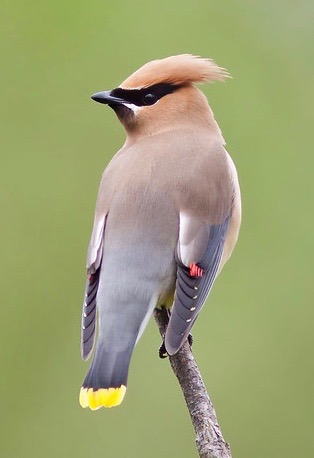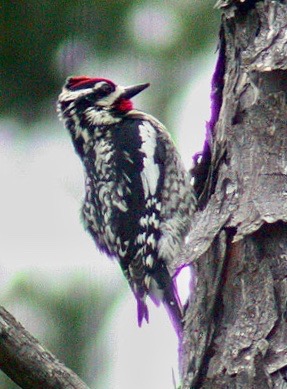I hope that I’m not offending anyone if I use the phrase “Indian Summer.” It’s always been one of my favorite times of year, and I use the expression with great respect and fondness (anyone know the Poco song Indian Summer?). Saturday was definitely an Indian Summer morning starting quite chilly but then eventually warming up nicely with wonderful bright fall sunshine.
The South Platte was as low as I’ve ever seen it, but that apparently made no difference to the ducks, and the streamside willows were hopping with Song Sparrows, Black-capped Chickadees, and Bushtits. The main ducks were Mallards, Gadwall, and Buffleheads, but then we also picked up some American Wigeon and Hooded Mergansers. So, the winter ducks are starting to show up, but, frankly, we didn’t see as great a variety as I was hoping for. Perhaps one of the reasons had to do with the pond on the west side of the river that is for the time being completely dry. There was a lone pole sticking up out in the middle from which a Say’s Phoebe was sallying out and taking insects off the dried mud, but certainly no ducks, or egrets, or herons.
Fortunately for us, once it warmed up, it turned out to be a good day for the landbirds. There were several highlights. First there was a flock of twenty or so Cedar Waxwings right by the parking lot partaking of a juniper berry breakfast. Cedar Waxwings are late breeders because of their dependence on ripening fruit, and, apparently, we can see juvenile waxwings as late as January. However, and this is just a personal observation, I feel like I was seeing a lot of juveniles in the early part of the breeding season this year, and all of the birds I saw on Saturday were adults. So, there may be some year-to-year fluctuations. Other interesting facts about Cedar Waxwings are that they regularly produce a second brood, starting nesting activity while the first brood may be only about seven days old, and they are apparently monogamous within a breeding season.
We were also treated to a nice mix of the different subspecies of Dark-eyed Junco – Slate-colored, Oregon, Pink-sided, and White-winged. It’s fun to start recognizing these different guys. I encourage you to take some time looking at them in your field guide. One of the great places to begin is by noticing whether a bird you’re looking at has black lores or not – the lore is the area between the eye and the bill. The Pink-sided, White-winged, and Gray-headed have black lores, while the Oregon, Slate-colored, and Cassiar tend to have a uniformly colored head. Then of course, also pay attention to whether your bird has rusty-pink flanks. Juncos can be regular visitors to our feeders so you should have ample opportunity to study up in the coming months.
Finally, the real highlight of the day was a juvenile Yellow-bellied Sapsucker. Of the four sapsuckers found in North America, we have two that breed each year in our mountains, Williamson’s and Red-naped. The Yellow-bellied Sapsucker is primarily an eastern species though they do breed as far west as the Yukon Territory (check out the distribution map in your field guide), and then in migrating to their wintering grounds in the southeastern US, eastern Mexico and Central America, a few pass through Colorado each fall. One of the keys to differentiating juvenile Yellow-bellied from the very similar juvenile Red-naped is that Red-naped juveniles generally acquire their adult plumage by October, Yellow-bellied juveniles may not get their adult plumage until early next year.
Overall, we had a great morning filled with more bird info than some people may have wanted. But, that’s why we like this birding game so much, right? There’s always something else cool to learn.
Good birding! Chuck
Hudson Gardens, Oct 31, 2020
31 species (+4 other taxa)
Canada Goose 80
Gadwall 12
American Wigeon 8
Mallard 28
Bufflehead 12
Hooded Merganser 2
Rock Pigeon (Feral Pigeon) 19
Eurasian Collared-Dove 4
Killdeer 3
Ring-billed Gull 23
Red-tailed Hawk 1
Belted Kingfisher 1
Yellow-bellied Sapsucker 1
Downy Woodpecker 2
Northern Flicker 7
Say’s Phoebe 1
Blue Jay 2
Black-billed Magpie 23
American Crow 4
Black-capped Chickadee 13
Bushtit 7
Red-breasted Nuthatch 3
White-breasted Nuthatch 4
American Robin 7
Cedar Waxwing 22
House Finch 15
American Goldfinch 5
Dark-eyed Junco 1
Dark-eyed Junco (Slate-colored) 1
Dark-eyed Junco (Oregon) 1
Dark-eyed Junco (Pink-sided) 3
Dark-eyed Junco (White-winged) 1
White-crowned Sparrow (Gambel’s) 1
Song Sparrow 6
Red-winged Blackbird 25






Thanks for such a great summary. Your comments and pictures are appreciated. Peggy Gordon